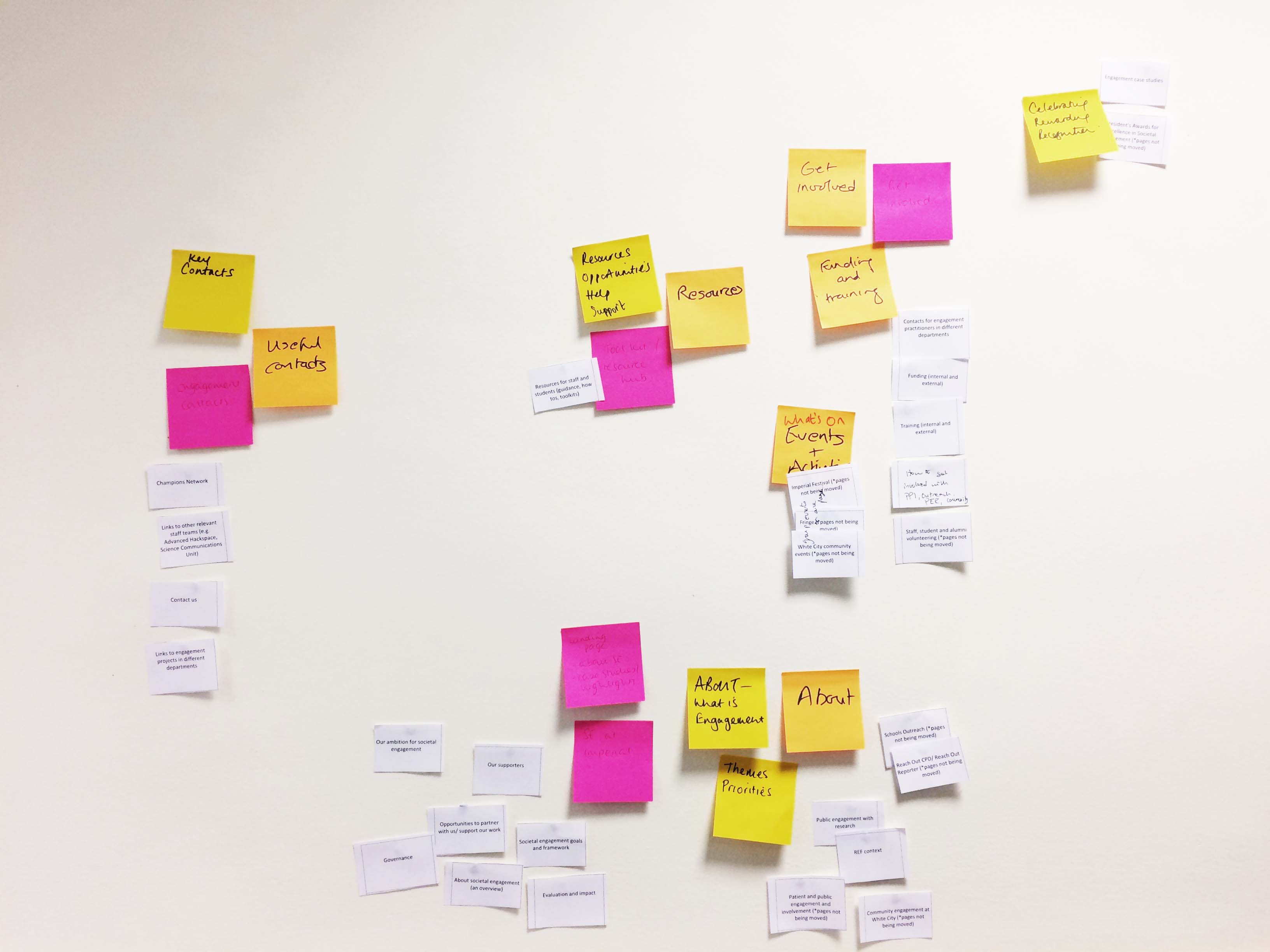
One really popular technique when planning a new website or a redesign is card sorting. This involves some willing participants being presented with a number of cards, each representing a piece of website content or information. For example: ‘contact form’, ‘Support FAQs’, ‘course list’ or ‘news’.
The aim of the game is to ask them to organise the cards into groups to form a potential structure (information architecture) for the content on the website.
So why is this useful?
It helps you plan, organise and prioritise the content on your website. I have also found it interesting to hear the discussions that people have as they sort the cards, which can give you a glimpse into how they think as they navigate your website. These are the kind of insights you don’t get from just looking at page views or search data.
How this technique has been used at Imperial
Cathy Thomas (Office of the Provost) recently carried out a card sorting workshop to help organise the content for the new Societal Engagement section of the site:
“I ran a card sorting workshop to help with developing a new set of web pages for Societal Engagement. It was a hugely useful exercise that prompted a diverse group of stakeholders to have open, productive conversations about audiences and priorities, and how we could balance these different needs; having a range of opinions in the room meant that the process was rigorous, so that content groupings and labels were thoroughly questioned and rationalised. It also prompted conversations around future needs and developing a structure that had some longevity. The card sort made having conversations about websites really inclusive – particularly when discussing navigation best practice and user experience with non-digital staff – and crucially the exercise gave me both the extra research and buy-in to move the project along further.“
Cathy Thomas, Engagement Coordinator in the Office of the Provost
Planning a workshop
Creating the cards
Each card should represent a piece of content or information on your website. Sounds simple right? But, if you make the cards too granular, you will produce too many. You can also fall into the trap of grouping content on the cards themselves. For example, ‘Help FAQs and support contacts’, these are two separate bits of content.
Top tip: write up an initial list of card labels and get the views of a few (trusted) colleagues before writing out the final cards.
How many cards?
The number of cards you create depends on the size and complexity of your site, but you should aim for fewer than 50 cards. Any more than that and the sessions will become too long and participants will lose interest…

…and even develop card sorting rage!
Group or individual sessions?
One of the first questions to ask yourself is how you want to structure the workshops. They can be carried out with individuals or groups, both have advantages and disadvantages.
Individual
The main advantage of these is that you get one unbiased view of how the content should be grouped per session. There is one big disadvantage though. In order to get useful data you may need to carry out at least 15 sessions (according to research by Jakob Nielsen), which will be very time consuming. This is why individual card sorts are usually carried out using online tools. I will talk about these tools in my next post.
Group
The alternative is group workshops. These could involve 2-10 people working together to determine the content grouping. The main advantage is that groups can discuss their views and come to a consensus. This means that you would only have to run one or two workshops to get useful data. One rare, but potential downside is, you can sometimes get dominant personalities influencing others in the group. To mitigate this, you could run a couple of sessions with no more than eight people in each and aggregate the results.
Whether you opt for individual or group card sorts, one thing that is common to both is that you must try and use real users of your website. This should involve as many of your different audience groups as possible. For example, you could have the first workshop with students and another involving staff, or you could have mixed sessions.
The key is that you get real, unbiased results!
Open or closed?
So, you have your cards and you know who you are going to invite, great. The next thing you need to decide is what type of card sort you are going to ask your participants to do. There are two main types:
- Open – The most common type of card sort. This involves asking the participants to group related cards and then name the groups they have formed.
- Closed – You create fixed groups and then ask the participants to organise the cards into them.
There is actually a third option too which is a hybrid sort. With a hybrid sort you create some or all of the groups. Participants can use these or create their own.
Which technique is best?
The type of card sort you choose depends on what you want to achieve and the type of project it is. For a new website project I would always recommend an open sort, as you are starting from scratch, so this is an opportunity to find out how potential users think about your content.
A closed sort tests how people organise the content into the existing structure, but it does not promote participants to think freely about the grouping of content.
A hybrid sort can be useful if you have confidence in some groups i.e. they are used commonly elsewhere on the Imperial or other websites like GOV.UK. Examples of these groups could be ‘About us’, ‘Contact us’ or ‘Help and Support’. Although a hybrid sort has the advantage of giving participants flexibility, more often than not the existing groups will lead them, so bear this in mind.
Need further advice?
There is a lot of information about planning and running card sorts out there, so I have included links to a few good resources at the bottom of this post. Alternatively you can contact me if you need any pointers.
Next post: Tools to help with card sorting and tree testing
Planning and running these workshops can be time consuming and tricky to organise, but once again help is at hand. There are a couple of tools that can help with both card sorting and another similar technique known as tree testing. These tools gather the data, enable you to run the workshops remotely and more importantly eliminate the need for creating physical cards. I will talk through a couple of these tools in my next post.
Useful links
- Card Sorting: Uncover Users’ Mental Models for Better Information Architecture – Nielsen Norman Group
- Card Sorting: How Many Users to Test – Nielsen Norman Group
- Card Sorting: Better Information Architecture by Aligning with Users’ Mental Models – Micah Bowers (Toptal)
- Book: Card Sorting – Designing Useful Categories by Donna Spencer
- Book: The Content Strategy Toolkit by Meghan Casey
`